 Download PDF
Download PDF
Name: Parthenocissus quinquefolia (L.) Planch.
Family: Vitaceae, the Grape Family
Common Names: Virginia creeper, woodbine, five-leaved ivy, American ivy (5).
Etymology: Quinque is Latin for “five” and folia means, “leaf”. Partheno is Greek for “virgin” and kissos means “ivy” (2).
Botanical synonyms (3, 9):
Amphelopsis latifolia Tausch
Amphelopsis quinquefolia (L.) Michx.
Hedera quinquefolia L.
Parthenocissus hirsuta (Pursh) Graebn.
Psedera quinquefolia (L.) Greene
Vitis inserta Kerner
Vitis quinquefolia (L.) Lam.
Quick Notable Features:
¬ Palmately compound leaves
¬ Leaves turn red early in autumn; can be seen from a distance on tree trunks
¬ Tendrils end in adhesive discs
¬ Globose, dark blue or blue-purple fruits
Plant Height: High climbing, reaching 15-20m (3, 9).
Subspecies/varieties recognized:
Parthenocissus quinquefolia (L.) Planch. var. hirsute (Pursh) Planch.
Parthenocissus quinquefolia (L.) Planch var. murorum (Focke) Rehd.
Parthencissus quinquefolia (L.) Planch. var. saintpaulii (Koehne ex Graebn.) Rehd. (9).
Most Likely Confused with: Parthenocissus vitacea (leaf morphology is identical) and Toxicodendron radicans (Poison ivy).
Habitat Preference: Prefers moist soils, but thrives in a variety of habitats and forest communities, from swamps to upland deciduous forests. It is a moderately shade tolerant, opportunistic vine, colonizing open places, roadsides, banks, stream and lakeshores, and fence rows (1, 2, pers. obs.).
Geographic Distribution in Michigan: Native to Michigan; Counties where P. quinquefolia is not found, or has not been reported to the USDA are: Antrim, Arenac, Bay Newaygo, Branch, Chippewa, Clare, Crawford, Delta, Genesee, Gladwin, Iosco, Kalkaska, Lake, Macomb, Manistee, Mason, Missaukee, Montmorency, Ogemaw, Otsego, Ottawa, and Van Buren (4).
Known Elevational Distribution: It is found in Utah at elevations of 1360 – 1520m (11).
Complete Geographic Distribution: Native to North America. It is widely distributed throughout the eastern and central United States, reaching its western limit in Utah and Colorado. Except North Dakota, it is found in every state east of Colorado. Outside of the United States, it is found in northern Mexico, and in Canada from Nova Scotia to Ontario (3, 4).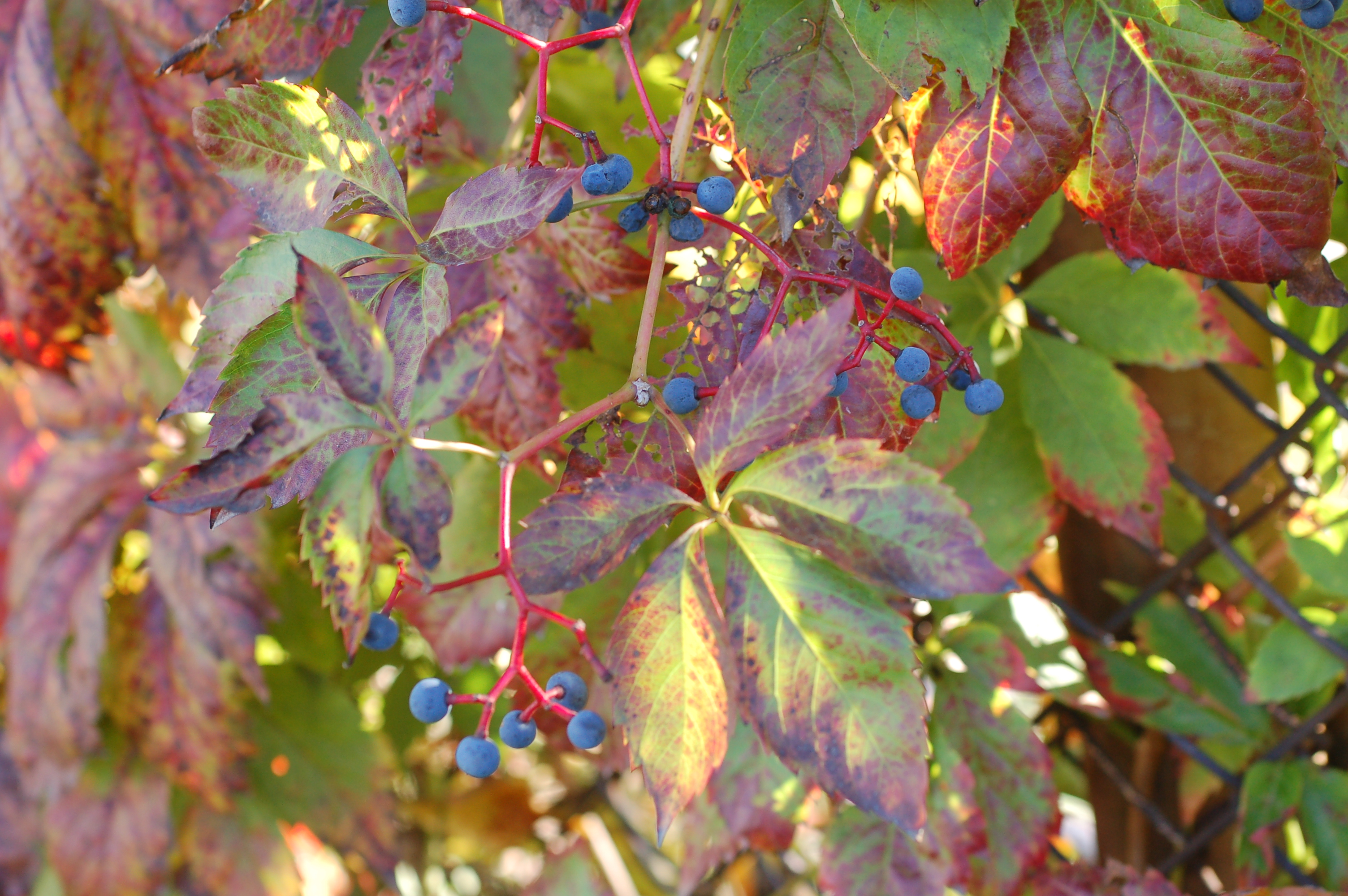
Vegetative Plant Description: Leaves are alternate, palmately compound with 5 leaflets on long petioles from 3-18cm in length. Leaflets are 4-12 cm long with short petiolules. Leaflet shape is elliptic to oblong-obovate with an acuminate or acute tip and a coarsely serrate margin; leaflet base is entire. Leaves are dull green above and pale underneath. Petioles and leaf underside are somewhat pubescent. Leaves standout in late summer and early fall due to their red to red-purple color; they can be seen from a distance on tree trunks. Twigs are orange brown, light brown, or gray with prominent lenticels and soft pubescence. They are slender with swollen nodes and leaf scars that are round and concave. Lateral buds are conical, gray and orange. No terminal bud is present. The bark is deeply furrowed with interlacing ridges and orange inner bark. Produces adventitious roots (1, 2, 3, pers. obs.).
Climbing Mechanism: Branching tendrils end in adhesive discs. Tendrils usually have 5-8 alternating branches and form opposite the leaves. There is a “tendril-less node” – a leaf with no opposed tendril – which separates every two nodes with tendrils. Buds form in the axil of the leaf in the tendril-less nodes. The discs adhere by means of a mucilage they produce when stimulated. Once the mucilage dries up, the disc becomes anchored to the substrate (so much so that the vine will damage its support if ripped off), the tendril then coils or contracts to pull the vine closer to its support (1, 2, 7, pers. obs.).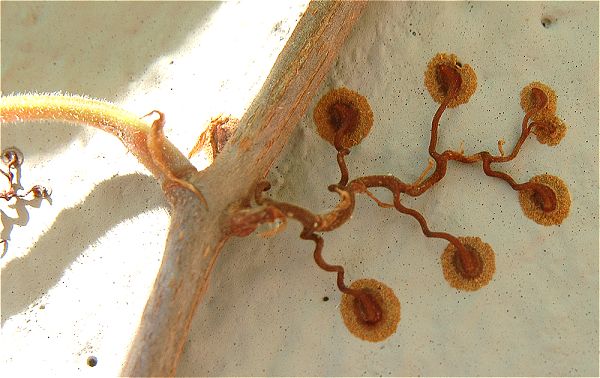
Flower Description: Reproductive organs are borne on short shoots found on older branches. Inflorescences form opposite the leaf in the same pattern described for tendrils with the shoot terminating in a compound inflorescence. The leaves that form on the short shoot are smaller and eventually abscise, so that all inflorescences born on the shoot may appear to be one inflorescence. Flowers are born on cymes or panicles of cymes. The pedicel is red. Each flower is perfect (sometimes unisexual), about 6mm across, has 5 stamens, a superior ovary with 2-6 locules, and 5 greenish white petals (1, 2, 6, 9).
Flowering Time: In the Midwest, flowering occurs mid-July to mid-August (9).
Pollinator: Flowers are insect pollinated. Honeybees are an important pollinator (9).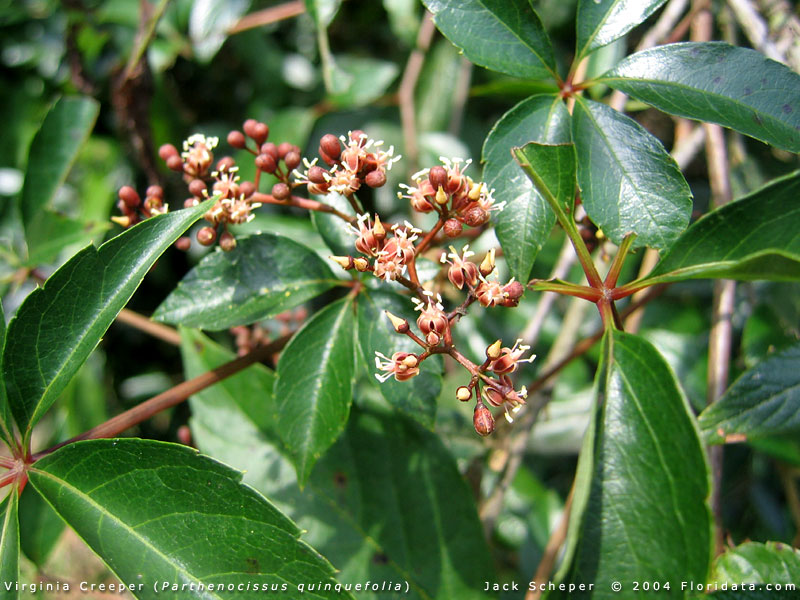
Fruit Type and Description: The fruit is a berry ripening in Michigan from September-October. It is globose, dark blue to blue-purple, with a slight bloom. Each berry is about 5-8mm across with 1 to 3 seeds inside. The fruit is considered poisonous to mammals (1, 2, pers. obs.).
Seed Description: Seed is round, heart-shaped, and two-toned – orange-brown and dark brown. A circular outline appears on its back (4).
Dispersal Syndrome: Birds use P. quinquefolia’s dense foliage for cover and are the main seed dispersers (3). Some species reported to use the plant for food in New England are woodpeckers, flycatchers, vireos, bluebirds, and thrush (13).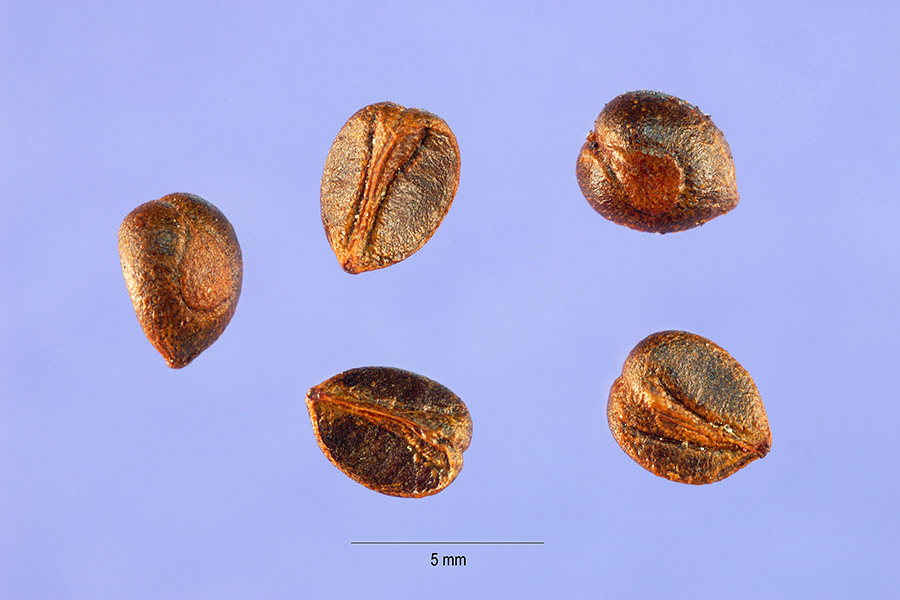
Distinguished by: 1) Distinguished from P. vitacea (a.k.a. P. inserta) by tendril morphology and slightly more leaf pubescence. P. vitacea lacks adhesive discs; its climbing mechanism is a twining tendril. Thus, it is not as prolific a climber as P. quinquefolia and is unable to ascend to the same heights. If a tendril of P. vitacea fails to make contact with a substrate it will remain on the vine, whereas in P. quinquefolia it will abscise. P. vitacea is also sometimes referred to as Virginia creeper, the same common name as P. quinquefolia (1, 7).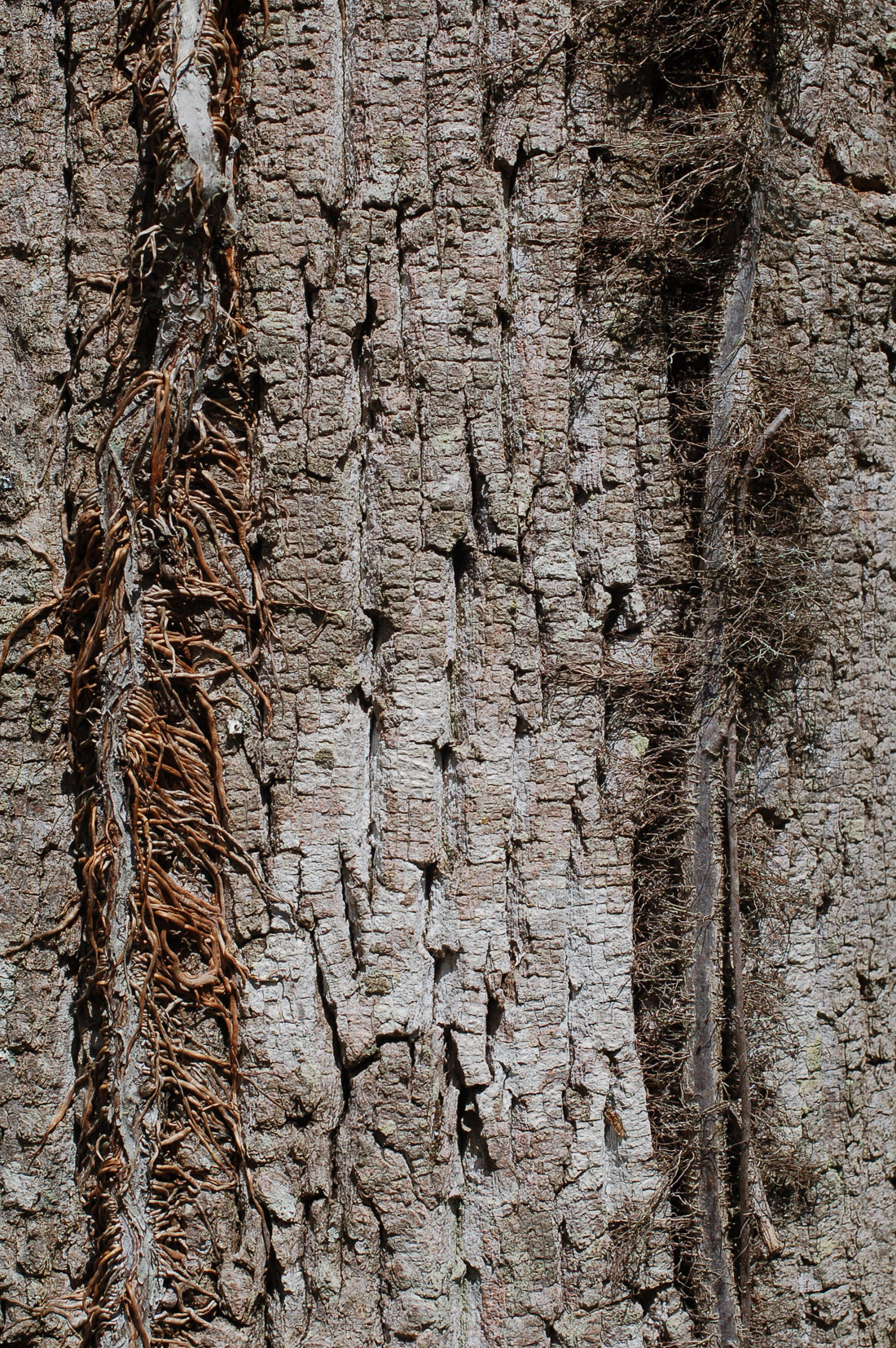
2) Distinguished from Toxicodendron radicans by leaf morphology. T. radicans has three leaflets and P. quinquefolia has five leaflets. However, if no leaves are available, and the two vines can often be found growing side by side, they can be confused. Both have adventitious roots; T. radicans’ roots are more fine and hair-like, whereas P. quinquefolia’s roots are thicker (spaghetti size). T. radicans also has a distinctive terminal bud, and P. quinquefolia has no terminal bud. The images below should better illustrate these distinctions. The adventitious roots and twig on the left are Parthenocissus quinquefolia and those on the right are Toxicodendron radicans .
Other members of the family in Michigan (number species): Ampelopsis (2), Vitis (4).
Ethnobotanical Uses:
| Affliction | Prescription | Source |
| Diarrhea | Decoction of the root | Meskwaki |
| Jaundice | Infusion of the plant (part of plant not specified) | Cherokee |
| Menstrual cramps | Decoction of the bark | Iroquois |
| Poison sumac | Decoction of twigs taken internally or applied externally | Iroquois |
| Swellings | Decoction of stems and leaves applied externally | Houma |
| Tetanus | Poultice of crushed leaves and vinegar applied externally | Houma |
| Wounds | Poultice of crushed leaves and vinegar applied externally | Houma |
Other uses: Food: the Ojibwa cooked the root. Dye: the Kiowa used fruits to paint skin and feathers (8).
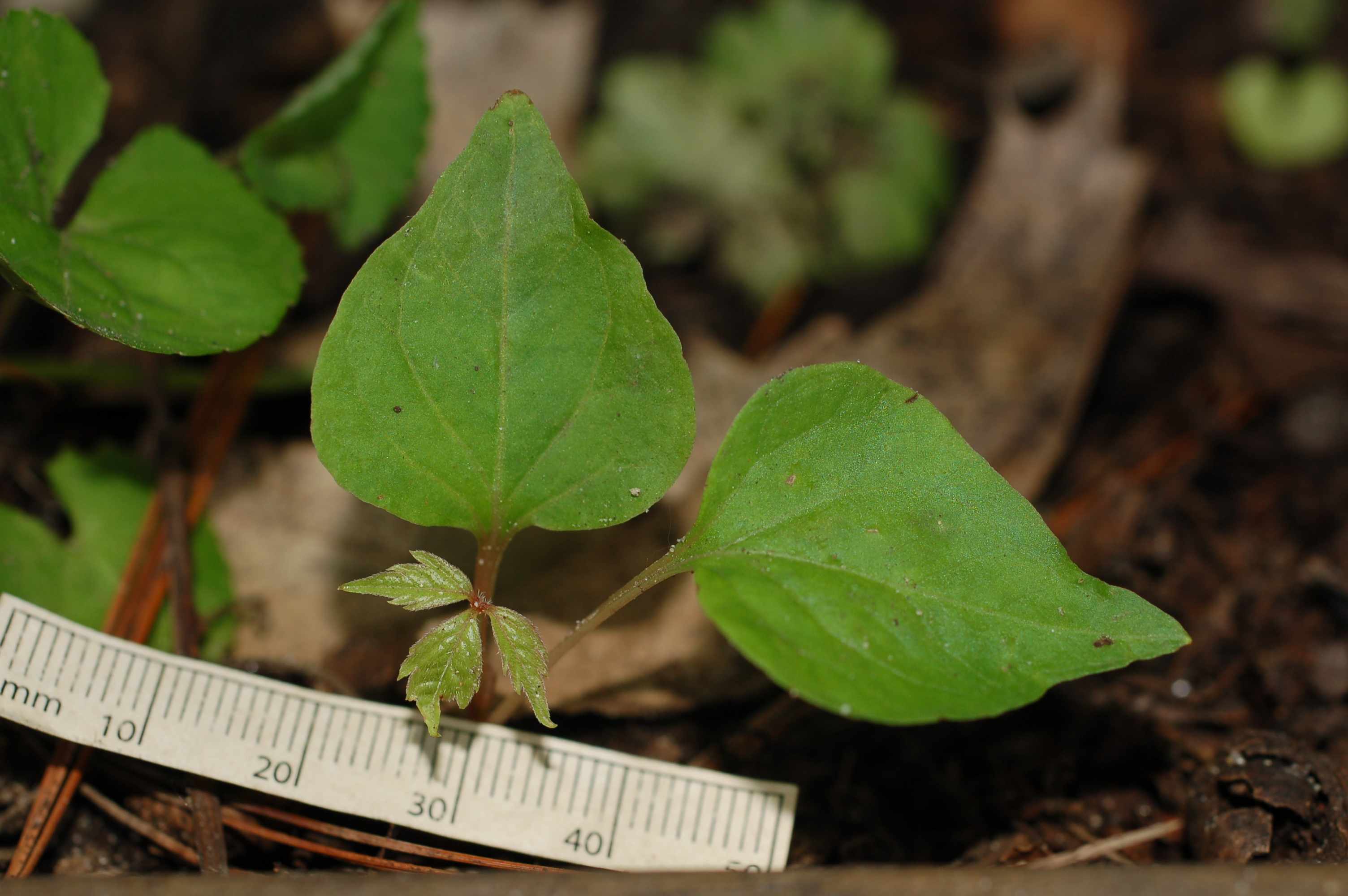
Phylogenetic Information: The family Vitaceae of the Vitales order is a core eudicot in the Rosid Angiosperms. They are the only family in the order. Vitaceae is placed as a sister to all the other rosids. Vitaceae may be most closely related to members of the Dilleniales, e.g. Dilleniaceae (10, 14).
Interesting Quotation or Other Interesting Factoid not inserted above:
Charles Darwin made many interesting observations of Virginia Creeper in his book, Movements and 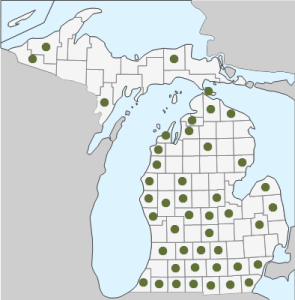 Habits of Climbing Plants. At one point, he observed how the vine carefully arranged its tendrils and began to push on a surface. The tips of the tendrils proceeded to swell and form discs within 38 hours. After firmly adhering to a surface, the tendrils continued to increase in thickness and strength. Darwin said, “The gain in strength and durability in a tendril after its attachment is something wonderful. There are tendrils now attached to my house, which are strong, and have been exposed to the weather in a dead state for fourteen or fifteen years. One single lateral branchlet of a tendril, estimated to be ten years old, was still elastic and supported a weight of exactly two pounds…so that after having been exposed during ten years to the weather, it would probably have resisted a strain of ten pounds!” (12). A cutting of Virginia creeper can grow roots 52-62cm long in 7 weeks, depending on competition with other species (15).
Habits of Climbing Plants. At one point, he observed how the vine carefully arranged its tendrils and began to push on a surface. The tips of the tendrils proceeded to swell and form discs within 38 hours. After firmly adhering to a surface, the tendrils continued to increase in thickness and strength. Darwin said, “The gain in strength and durability in a tendril after its attachment is something wonderful. There are tendrils now attached to my house, which are strong, and have been exposed to the weather in a dead state for fourteen or fifteen years. One single lateral branchlet of a tendril, estimated to be ten years old, was still elastic and supported a weight of exactly two pounds…so that after having been exposed during ten years to the weather, it would probably have resisted a strain of ten pounds!” (12). A cutting of Virginia creeper can grow roots 52-62cm long in 7 weeks, depending on competition with other species (15).
Literature and websites used:
- Voss, E.G. 1985. Michigan Flora, Part II Dicots. Bloomfield Hills: Cranbrook Institute of Science.
- Fernald, M.L. 1970. Gray’s Manual of Botany, 8th edition. New York: American Book Co.
- USDA Forest Service. http://www.fs.fed.us/global/iitf/pdf/shrubs/Parthenocissus%20quinquefolia.pdf
- USDA Plants Profile Database. http://plants.usda.gov/java/profile?symbol=PAQU2
- Soper, J.H. & M.L. Heimburger 1982. Shrubs of Ontario. Ontario: Royal Ontario Museum.
- Wilson, T. & U. Posluszny 2003. Novel variation in the floral development of two species of Parthenocissus. Canadian Journal of Botany 81: 738-748.
- Wilson, T. & U. Posluszny 2003. Complex tendril branching in two species of Parthenocissus: implications for the vitaceous shoot architecture. Canadian Journal of Botany 81: 587-597.
- Moerman, D. 2006. Native American Ethnobotany Database. http://herb.umd.umich.edu/herb/search.pl?searchstring=Parthenocissus+quinquefolia
- Virtual Herbarium of the Chicago Region. http://www.vplants.org/plants/species/species.jsp?gid=28711
- Angiosperm Phylogeny Group 2009. An update of the Angiosperm Phylogeny Group classification for the orders and families of flowering plants: APG III. Botanical Journal of the Linnean Society 161(2): 105-121.
- Digital Atlas of the Vascular Plants of Utah. http://www.gis.usu.edu/Geography-Department/utgeog/utvatlas/family/vita/paqu.html
- Darwin, C. 1876. Movements and Habits and Climbing Plants. New York: D. Appleton & Co.
- Patmos, W. 1995. New Hampshire’s native trees, shrubs, and vines with wildlife value. University of New Hampshire Cooperative Extension. Available at:
extension.unh.edu/resources/files/Resource000427_Rep449.pdf - Stevens, P.F. (2001 onwards). Angiosperm Phylogeny Website. Version 9, June 2008 [and more or less continuously updated since]. http://www.mobot.org/MOBOT/research/APweb/.
- Emerine, S.E., R.J. Richardson, & C. Arellano 2013. Porcelain berry (Ampelopsis brevipedunculata), bushkiller (Cayratia japonica), and Virginia-creeper (Parthenocissus quinquefolia) in interspecific competition. Invasive Plant Science and Management 6(1): 99-104.
Image Credits (all used with permission):
1) Image of single leaf is from Plant Gallery – Image Plant Encyclopedia at http://plantsgallery.blogspot.com/
2) Image of leaves on tree trunk courtesy of Peter G. May at http://www.stetson.edu/~pmay/stock%20flora.htm
3) Image of fruits copyright Robyn J. Burnham, University of Michigan
4) Image of tendril is courtesy of Wayne Hughes © SparkleberrySprings.com
5) Flower cluster image is courtesy of Floridata.com.
6) Image of seeds is from the USDA-NRCS PLANTS Database, courtesy of Steve Hurst @ USDA-NRCS PLANTS Database
7 and 8) Image of stems and seedling copyright Robyn J. Burnham, University of Michigan
9) Species distribution map, derived from the Michigan Flora Online.
Primary Author: Michelle Medley with edits and additions by John Bradtke and Robyn J. Burnham
© Robyn J. Burnham, University of Michigan, last updated 4-2013
For additional information on Michigan Plant Diversity web pages please contact Robyn J. Burnham via email: rburnham“at”umich.edu